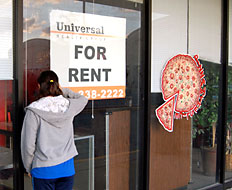In August, the NPD Group released its annual tally of U.S. restaurant closures, and the study proved a sobering reminder of the challenges independent restaurants face in any climate, let alone one sitting in recession-era shadows.
The NPD Group reported that 9,450 restaurants closed during a 12-month period beginning April 1, 2010. Nearly 92 percent of the closures, or 8,650 units, were independents, the steepest dive in that category since the Chicago-based market research firm began collecting the data in 2001.
Though quick serves can perhaps take comfort in the fact that 63 percent of the NPD-reported closures were full-service establishments, the disproportionate amount of independent closures spotlights the daunting climb such operations face. Quick serves in particular face steep challenges in a sector dominated by deep-pocketed, market-savvy chains.
“So many independents are juggling along, not getting profits, and counting pennies,” says James Sinclair of OnSite Consulting, a distressed restaurant consultancy headquartered in Los Angeles. “They’re using tomorrow’s money to pay yesterday’s bills, and that drives closures.”
While most peg today’s economic climate as the foremost threat to restaurant viability, industry insiders say quick-service independents face persistent and common challenges in any environment.
Off the bat, independents battle for a slim slice of the revenue pie. According to NPD Group data, major chains account for 72 percent of quick-service traffic, while independents only see 17 percent. (Small or regional chains account for the other 11 percent.)
“The quick-service segment is dominated by the major chains who have the wherewithal to develop new products, increase awareness, offer up discounts, and use considerable marketing clout to boost business,” NPD Group restaurant analyst Bonnie Riggs says, noting that dwindling access to capital has further hampered independents.
From daypart trends to flavor profiles, quick-service giants have teams studying consumers’ wants and desires and boast personnel dedicated to market analysis. The national names claim revenue-generating drive-thru operations, marketing pizzazz, and a deeper management bench that supports stumbling units.
In contrast, most independents operate on a shoestring, possessing neither the means nor the know-how to respond to bad business.
But the consistent battle against industry heavyweights isn’t the lone issue driving the staggering closure differential. An independent mindset too often rooted in passion over knowledge, Sinclair says, deserves attention as well.
“Outside of an idea and money, the restaurant industry has no barriers of entry, no certification, accreditation, or advanced business knowledge to get in the game,” he says.
Sinclair says the majority of independents he consults feature poor management driving the business into the red. There’s a widespread lack of knowledge on quick-service economics, such as process streamlining, sales, and quality assurance.
Even more, the owner-operator model so prevalent in independents often means the leader extinguishes small fires each day at the expense of achieving a big-picture objective view.
“I find too many holding things together on will power and a prayer,” Sinclair says of independents. “They think infrastructure and process are words for the big guys alone, and that’s not so.”
Veteran restaurant consultant Izzy Kharasch says too many independents were willing to cut staffing when economic turmoil hit but not willing to raise prices, alter products, or investigate controllable costs.
“So many get on the defensive and they slash staff or quality rather than looking at productive cost cutting,” says Kharasch, who runs Deerfield, Illinois–based Hospitality Works.
Kharasch suggests independents put their “purveyors’ feet to the fire,” turning to suppliers for better efficiencies, best practices, and value. Ordering cups in bulk or switching to different napkins, for instance, can spark savings without hampering the customer experience, he says
“Quick service is a business of pennies,” Kharasch says. “Operators need to watch every piece of their business, from the ketchup packets to the napkins, to see if there’s a better, more cost-effective way.”
Yet profitability is not based on cost cutting alone. Operators can also pursue raising the average ticket with beverages or side items, Kharasch says. For example, an operator might place high-margin “grab items” at the counter, such as fresh cookies, as a simple enticement.
“How do we get our current customers to spend more money and be happy about it?” Kharasch says.
Sinclair believes independents need to mimic the major chains’ insistence on data. Reviewing numbers on beverage sales, dinner sales, and dayparts can produce valuable insight on opportunities and spur new revenue streams.
“Too many people accept the status quo,” Sinclair says “Sometimes all it takes is a 10 percent conversion on a new offering to be profitable.”
Ultimately, Kharasch says, it’s important that independents embrace their inherent strength: light feet.
“When an independent operator has a good idea, he can implement it tomorrow. That’s something independents need to use to their advantage,” Kharasch says.





